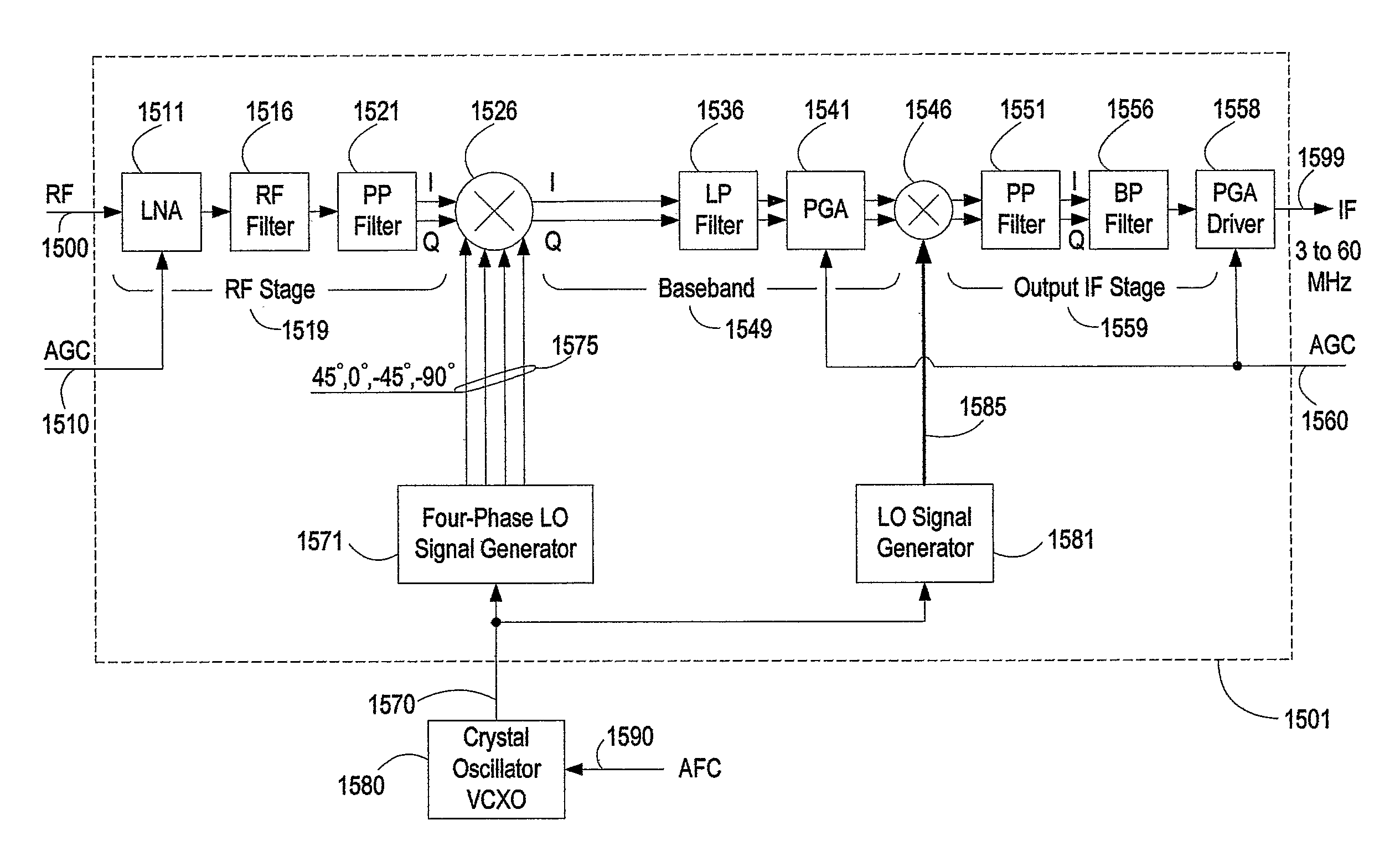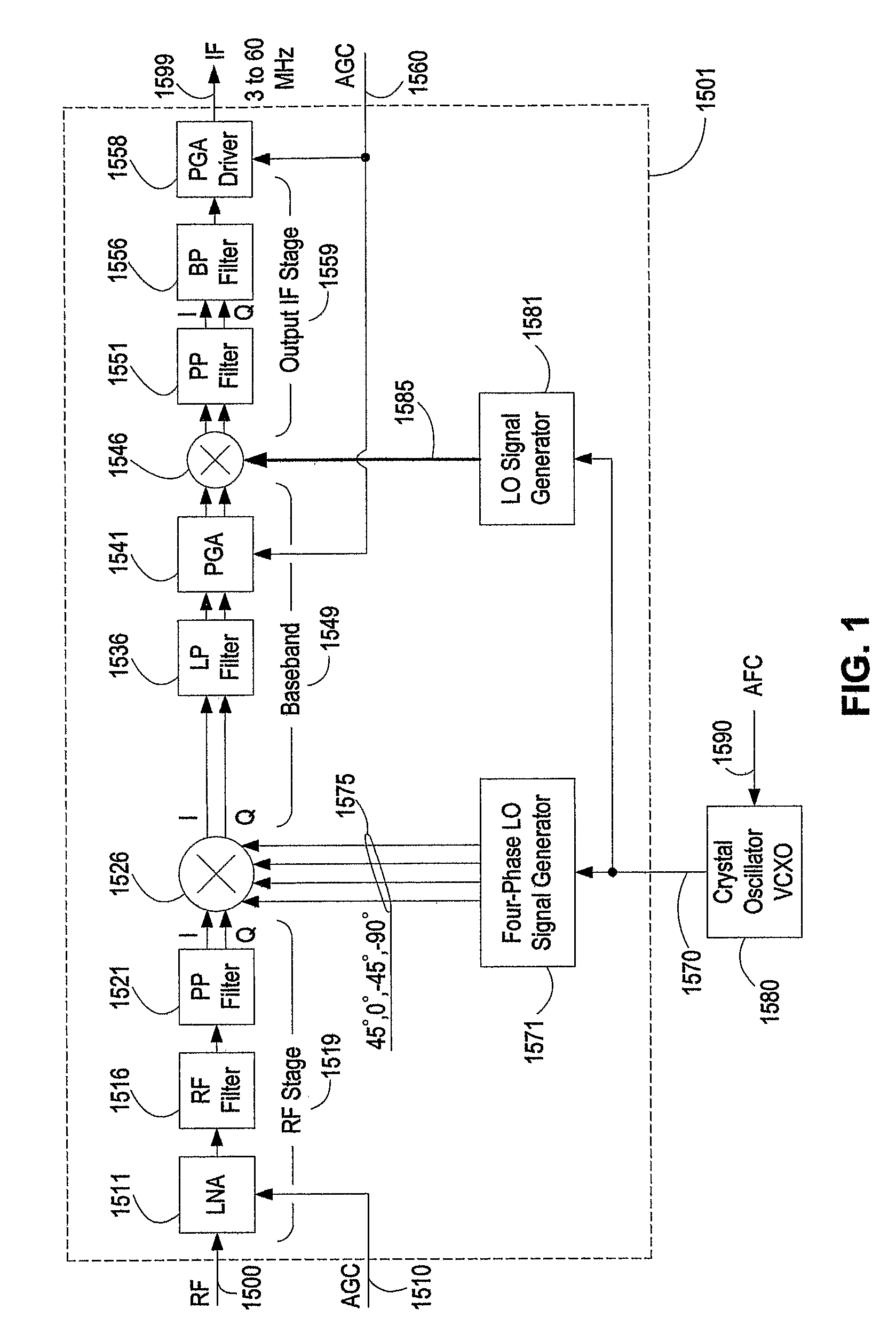Integrated Tuner for Terrestrial and Cable Television
a technology for terrestrial and cable television, applied in the direction of automatic frequency control details, demodulation, electrical equipment, etc., can solve the problems of difficult, if not impossible, to integrate this high-quality bandpass filter on-chip, and the ratio between the overall bandwidth of the frequency band 50 to 880 mhz and the center frequency is very high
- Summary
- Abstract
- Description
- Claims
- Application Information
AI Technical Summary
Benefits of technology
Problems solved by technology
Method used
Image
Examples
first embodiment
[0054] This invention presents a converter which is able to provide rejection of major high-order images in RF receivers, in any RF receivers for terrestrial, cable, wireless, etc. applications. Major high-order images are hereby termed to represent several lowest high-order images, and major odd-number high-order images are hereby termed to represent several lowest odd-number high-order images, preferably as, third-, fifth-, seventh- and ninth-order images. One objective of this invention is to provide this converter with a better image rejection capacity than those of conventional image rejection converters in the art. The present converter can be applied to integrated tuner 1501 and other embodiments presented later to significantly relax design constraints and improve dynamic ranges of amplifier and filter circuit blocks in RF stage 1519.
[0055] It is obvious in concept that the third- and fifth-order images do not exist in a linear mixer when a reference signal applied to do not...
embodiment 1651
[0077] Upconverter 1546 upconverts baseband desired signal 1549 to output IF 1559. FIG. 8 shows an embodiment 1651 of double quadrature upconverter 1546. Quadrature reference signal 1585 for upconverter 1546 has its frequency equal to the frequency of output IF 1559. For the same reason, upconverter 1546 is designed to minimize I / Q mismatch by using the large device matching technique. If the spectrum of the desired signal needs to be inverted in upconverter 1546, baseband desired signal 1549 is upconverted to output IF 1559 where the negative sideband is defined as the wanted sideband. In upconversion 1546, an embodiment of type-II single quadrature converter 1631 in FIG. 10 may be used but it will increase the design constraint of baseband LP filter 1536. Alternatively, double quadrature MIR converter 8500 in FIG, 6 may be used in upconversion 1546 to relax the design constraint of LP filter 1536, particularly for the frequency of output IF 1559 defined in a relatively low frequen...
embodiment 1611
[0103] In FIG. 20, type-I single quadrature converters 8021a-c may be implemented by using passive mixers or active switching mixers. An embodiment 1611 of type-I single quadrature converter is shown in FIG. 9, where mixer 1621 is either an active switching mixer or a passive mixer.
[0104] Three IF polyphase filters 8030a-c in the second stage of FIG. 20 are designed to suppress the IF image. A sideband of the image signal at RF input 1500 in FIG. 19 is downconverted to output IF stage 1539 as the IF image signal mirroring to the wanted sideband of the IF desired signal. The mismatch in any IF quadrature path in FIG. 20 causes a frequency crosstalk between the positive and negative sidebands. Hence IF polyphase filters 8030a-c are utilized to suppress this IF image in its first place in each of the three IF quadrature paths. FIG. 11B shows an embodiment of a two-stage polyphase filter 5710. IF polyphase filter 8030a-c should provide enough suppression of the IF image so that all the ...
PUM
 Login to View More
Login to View More Abstract
Description
Claims
Application Information
 Login to View More
Login to View More - R&D
- Intellectual Property
- Life Sciences
- Materials
- Tech Scout
- Unparalleled Data Quality
- Higher Quality Content
- 60% Fewer Hallucinations
Browse by: Latest US Patents, China's latest patents, Technical Efficacy Thesaurus, Application Domain, Technology Topic, Popular Technical Reports.
© 2025 PatSnap. All rights reserved.Legal|Privacy policy|Modern Slavery Act Transparency Statement|Sitemap|About US| Contact US: help@patsnap.com



